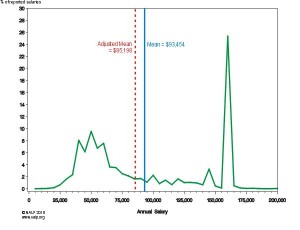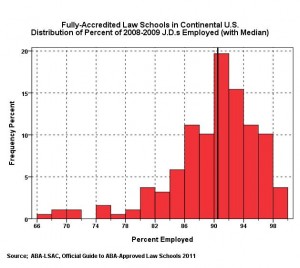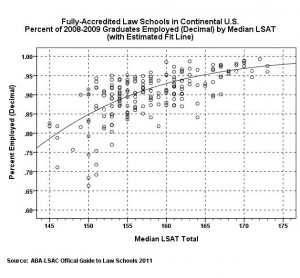Many law students enter law school with dreams of getting a job with one of the major law firms, but what are their chances of doing that? The NALP Salary Distribution, Curve for the Class of 2009 suggests that about 25% of reported salaries fell in the $160,000 range. But only 19,513 members of that class reported salaries. Using data from the 2011 edition of the ABA-LSAC Official Guide to ABA-Approved Law Schools (online version), those law schools granted 43,859 JDs in 2008-2009 academic year. The 2009 Salary Distribution Curve included information on only about 44% of the members of the Class of 2009. To what extent is there a selection bias in the NALP survey? To what extent are graduates who get jobs with big law firms and high salaries disproportionately likely to report their salaries?
There is increasing evidence that there is a large selection bias in the NALP salary surveys. First, as I discussed in The Market for J.D.s, the percentage of recent graduates employed varies widely among the law school, but generally falls as the median LSAT of a law school falls. Second, the recent report on Go-To Law Schools suggest that there may be a lot. As I discussed in Go To Law, that report lists the top 50 law schools from which the National Law Journal top 250 law firms drew first-year associates in the 2010 hiring season. According to that report, in 2009, the 50 Go-To law schools placed 30.3% of the Class of 2009 with NLJ-250 law firms, or about 4239 graduates (using the numbers for the Class of 2010), as compared to 4,878 persons (25% of the 19,513 persons included in NALP 2009 survey).
Second, if the sample included in the NALP 2009 survey represented the distribution of salaries for all 43,859 persons getting JDs from ABA-approved law schools in 2009, then about 10,965 persons in that class would have big-firm level salaries. Taking out the 4,239 graduates of the Go-To law schools, 6,726 of the 29,870 graduates of the remaining ABA-approved law schools, or about 22.5%, would have received jobs with big law firms. Yet the 5oth-ranked Go-To law school sent only 13.2% of its class to the NLJ-250 law firms in 2009 (10.57% in 2010).
Admittedly, these are back-of-the-envelope calculations. I don’t know the size of the 2009 classes of the 2009 Go-To law schools, so I’ve used the size of the 2010 classes. Most glaringly, different law schools were included in the top 50 in 2009 than were included in 2010. Also, I don’t know whether the proportion of graduates of Go-To law schools who got jobs with the NLJ-250 law firms that responded to the NALP salary survey was higher–or lower–than students who did not get jobs with the NLJ-250. That, of course is the point of those, including the ABA’s Young Lawyer’s Division (see Truth in Law School Education), who are calling for greater transparency in reporting job and salary information.



So You Want to Be a Rock ‘n’ Roll Star?
Thursday, March 3rd, 2011Many law students enter law school with dreams of getting a job with one of the major law firms, but what are their chances of doing that? The NALP Salary Distribution, Curve for the Class of 2009 suggests that about 25% of reported salaries fell in the $160,000 range. But only 19,513 members of that class reported salaries. Using data from the 2011 edition of the ABA-LSAC Official Guide to ABA-Approved Law Schools (online version), those law schools granted 43,859 JDs in 2008-2009 academic year. The 2009 Salary Distribution Curve included information on only about 44% of the members of the Class of 2009. To what extent is there a selection bias in the NALP survey? To what extent are graduates who get jobs with big law firms and high salaries disproportionately likely to report their salaries?
There is increasing evidence that there is a large selection bias in the NALP salary surveys. First, as I discussed in The Market for J.D.s, the percentage of recent graduates employed varies widely among the law school, but generally falls as the median LSAT of a law school falls. Second, the recent report on Go-To Law Schools suggest that there may be a lot. As I discussed in Go To Law, that report lists the top 50 law schools from which the National Law Journal top 250 law firms drew first-year associates in the 2010 hiring season. According to that report, in 2009, the 50 Go-To law schools placed 30.3% of the Class of 2009 with NLJ-250 law firms, or about 4239 graduates (using the numbers for the Class of 2010), as compared to 4,878 persons (25% of the 19,513 persons included in NALP 2009 survey).
Second, if the sample included in the NALP 2009 survey represented the distribution of salaries for all 43,859 persons getting JDs from ABA-approved law schools in 2009, then about 10,965 persons in that class would have big-firm level salaries. Taking out the 4,239 graduates of the Go-To law schools, 6,726 of the 29,870 graduates of the remaining ABA-approved law schools, or about 22.5%, would have received jobs with big law firms. Yet the 5oth-ranked Go-To law school sent only 13.2% of its class to the NLJ-250 law firms in 2009 (10.57% in 2010).
Admittedly, these are back-of-the-envelope calculations. I don’t know the size of the 2009 classes of the 2009 Go-To law schools, so I’ve used the size of the 2010 classes. Most glaringly, different law schools were included in the top 50 in 2009 than were included in 2010. Also, I don’t know whether the proportion of graduates of Go-To law schools who got jobs with the NLJ-250 law firms that responded to the NALP salary survey was higher–or lower–than students who did not get jobs with the NLJ-250. That, of course is the point of those, including the ABA’s Young Lawyer’s Division (see Truth in Law School Education), who are calling for greater transparency in reporting job and salary information.
Posted in Commentary, Employment, Law Firms, Law Schools | No Comments »